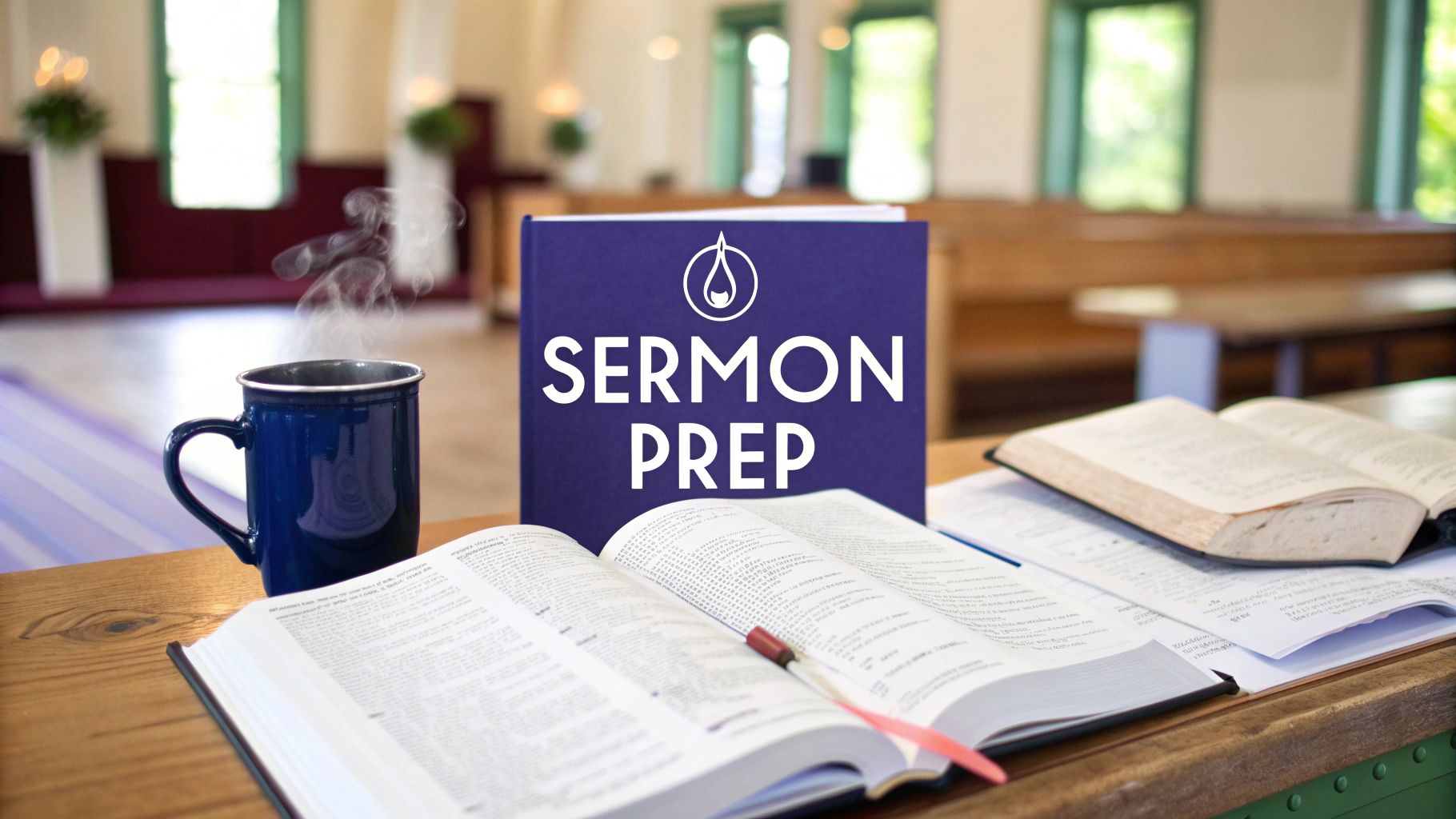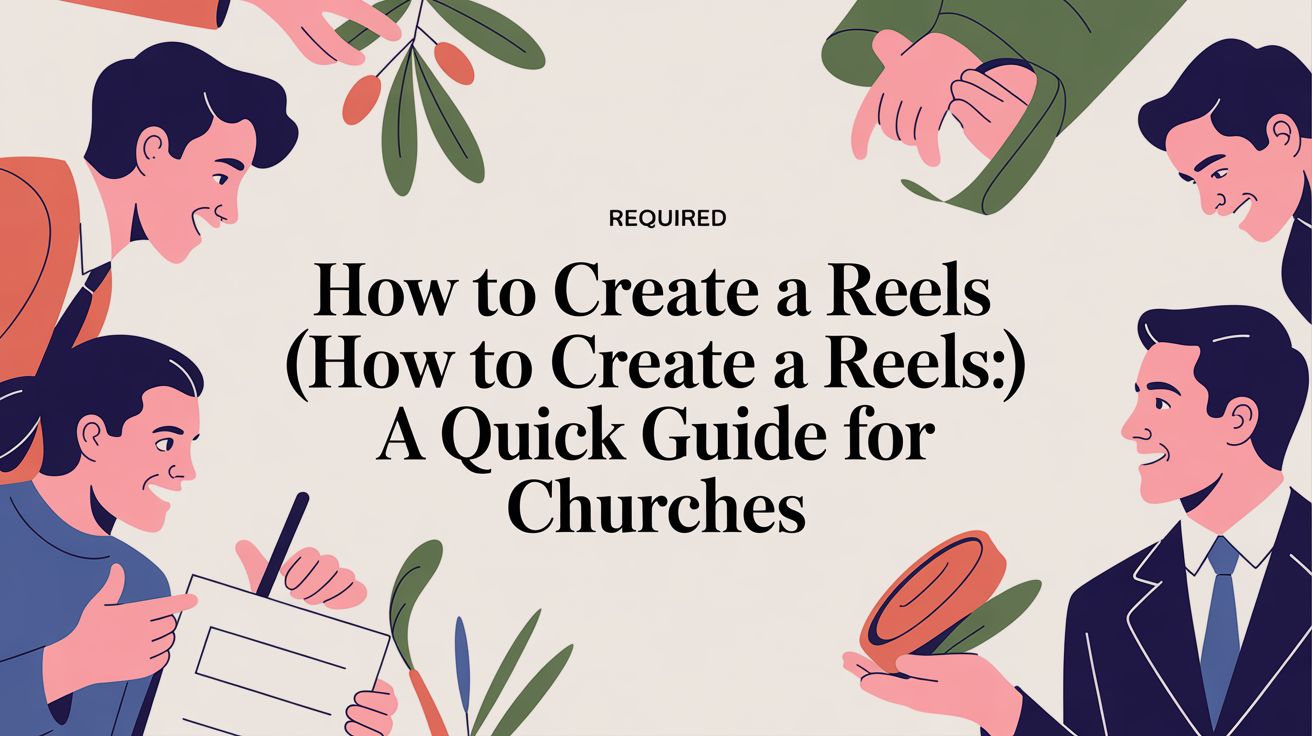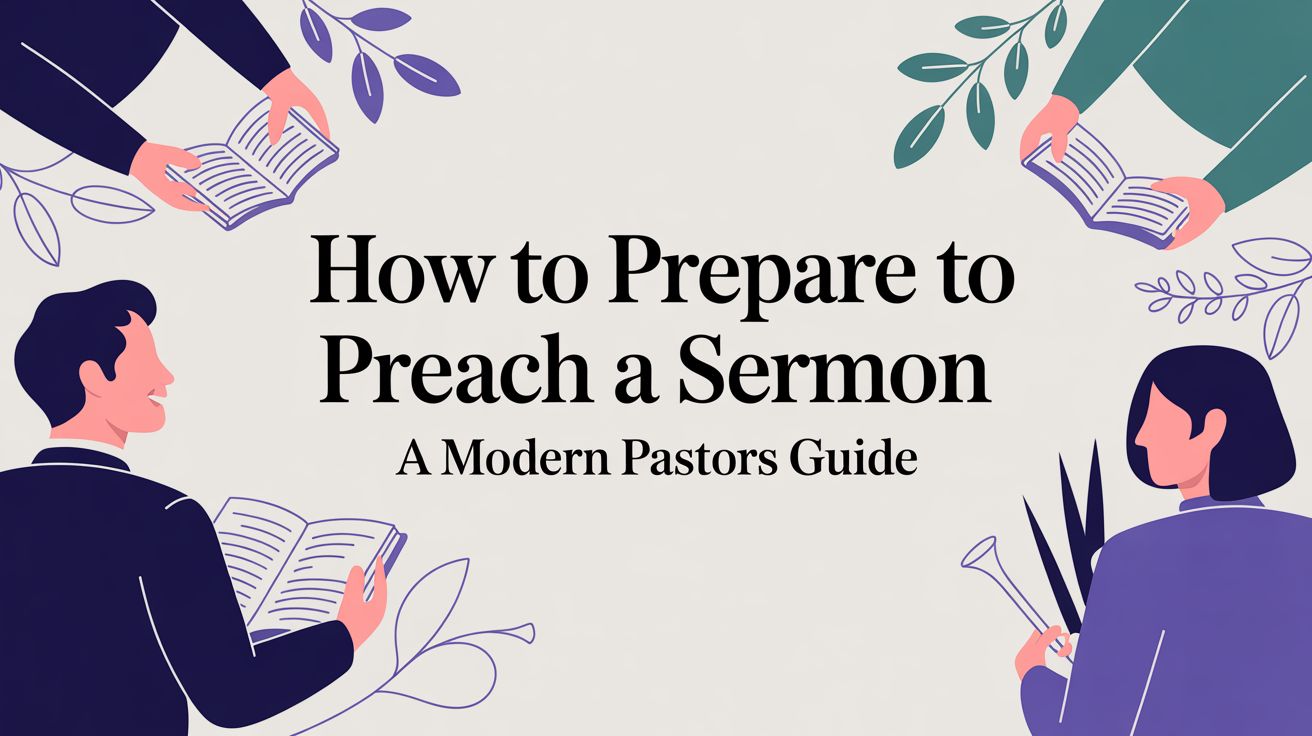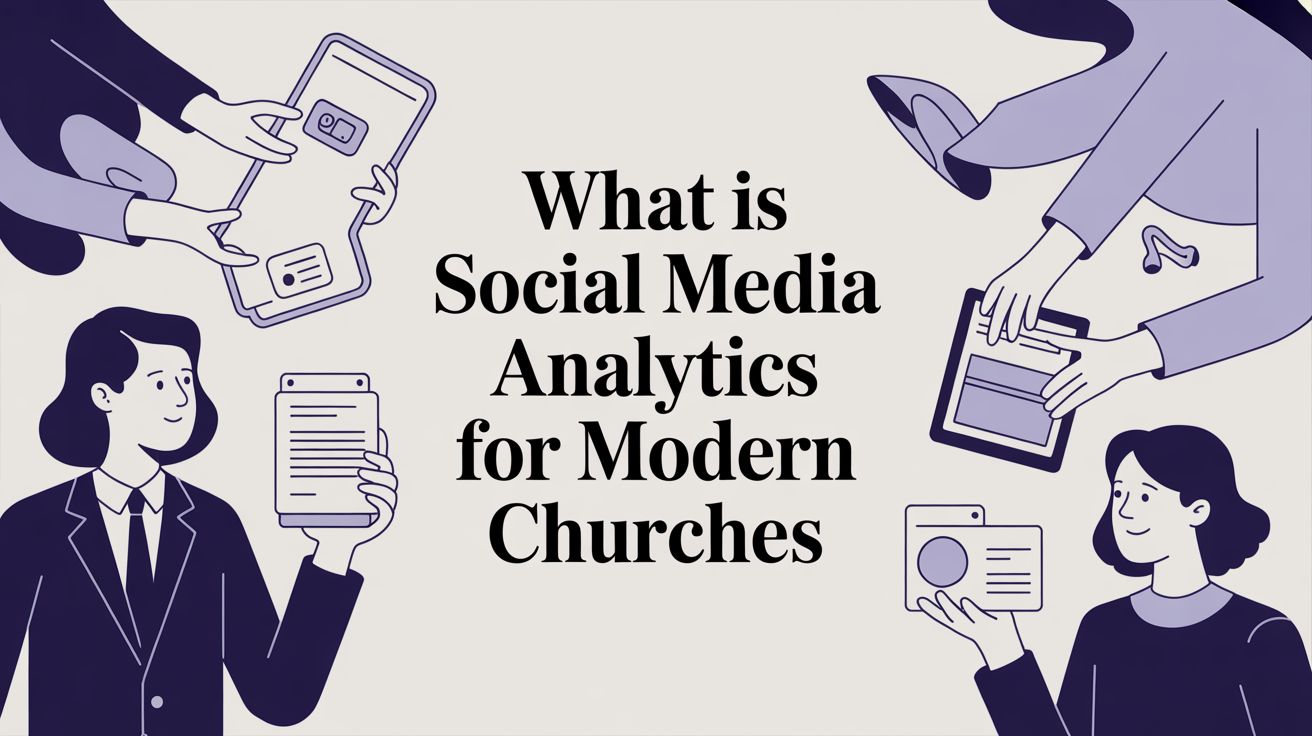Preparing a sermon is so much more than just jotting down a few notes for Sunday. It’s a deep dive—a process of prayerful study, careful structuring, and, most importantly, connecting timeless biblical truth to the messiness of everyday life. The real goal is to shift your mindset from a weekly checklist to a genuine spiritual discipline.
When you do that, you can be confident that the message you received in private is the one you faithfully deliver in public.
The Spiritual Foundation of Sermon Prep

Before a single word of the sermon is written, before an outline even begins to take shape, the most crucial work begins in your own heart and mind. This isn't about finding the perfect opening illustration or a clever productivity hack. It's about positioning yourself to hear from God before you ever attempt to speak for Him.
Think of it less as a task to complete and more as an act of worship.
This spiritual discipline completely transforms the process. Instead of cracking open the text and asking, "What can I say about this?" the question shifts to, "God, what are You saying through this?" That small change is monumental. It moves the focus from your performance to His proclamation, freeing you from the crushing pressure of having to invent something profound every single week.
Approaching the Text with Humility
Humility is the entry point. It’s the key that unlocks the whole thing. It requires you to acknowledge that the text has authority over you long before it has a message for your congregation.
This means you have to intentionally set aside your preconceived notions, your pet topics, and your own agenda. You have to let the Scripture challenge, convict, and shape you first. This initial phase of personal reflection is where the message gets its soul. A sermon born from a genuine, personal encounter with God's Word carries a weight and passion that simply can't be manufactured.
"Do not read the Bible to find texts for sermons, read it because it is food that God has provided for your soul, because it is the Word of God, because it is the means whereby you can get to know God." - D. Martyn Lloyd-Jones
This mindset guards against the all-too-common trap of viewing Scripture as mere source material. When the Word becomes your spiritual nourishment first, the sermon that follows is just the natural overflow.
Core Stages of Sermon Preparation
To put it all together, the entire process can be seen as a journey through a few core stages. Each one builds on the last, ensuring the final message is both faithful to the text and relevant to your listeners.
This table provides a high-level roadmap, but the heart of it all begins with that first stage: letting God speak to you.
Balancing Accuracy with Relevance
This spiritual foundation also demands a commitment to two pillars that must always stand together: theological accuracy and relational relevance.
One without the other just doesn't work. A message that's theologically accurate but lacks relevance feels like a sterile lecture. On the other hand, a message that's emotionally engaging but biblically shallow is just empty hype.
Here’s how they complement each other:
- Theological Accuracy: This is your homework. It’s the diligent study of historical context, literary genre, and the original meaning of the passage. It’s the hard work that ensures your message is faithful to what God actually said.
- Relational Relevance: This is your heartwork. It’s about knowing your people—their struggles, their questions, their daily grind. This empathy is what allows you to build a bridge from the ancient text directly into their modern lives.
Don't underestimate the time this takes. A 2021 poll revealed that the vast majority of pastors—nearly 70%—spend between 10 and 18 hours preparing a single sermon. You can read more about how pastors are using that time in this in-depth analysis. That huge investment isn't just for crafting a speech; it's for cultivating a message that has the power to genuinely change lives.
Uncovering the Core Message in Scripture
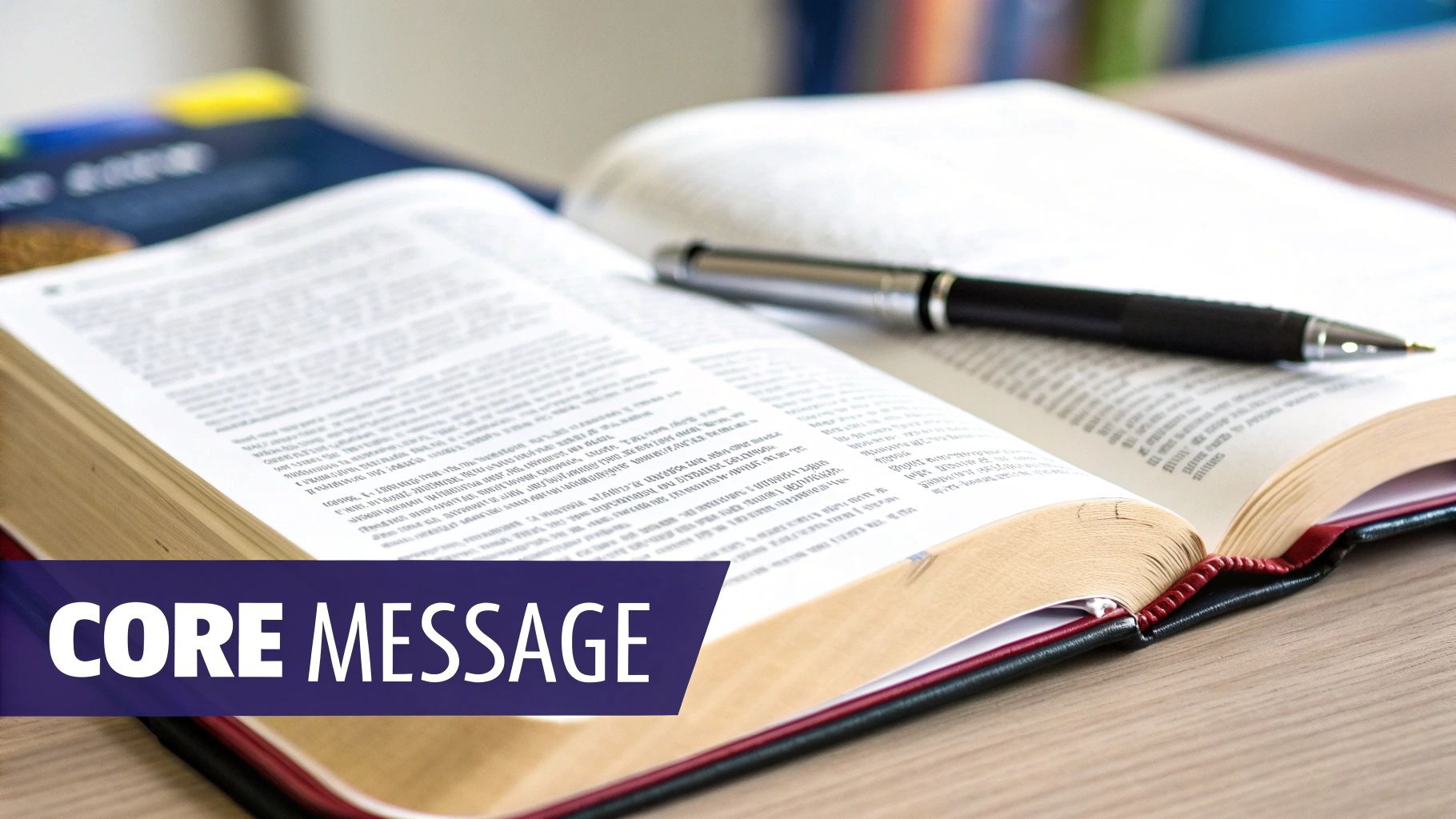
Okay, you've prayed and prepared your heart. Now it's time to roll up your sleeves and dive into the text itself. This is the deep exegetical work where we move from quiet reflection to rigorous study.
Our goal here is simple but profound: to understand what the original author was trying to say to his original audience. It’s a process called exegesis, which is just a fancy way of saying we're pulling the meaning out of the text instead of reading our own ideas into it.
This is the detective work. It’s what ensures your sermon is built on the solid rock of Scripture, not the shifting sands of your own opinion. Everything from this point forward hinges on discovering the central truth—the 'big idea'—that will anchor your entire message.
Starting with Context and Genre
Before you even think about breaking down a single verse, you have to zoom out. We need to understand the world the text was born into. This means looking at two key things: the historical setting and the literary form.
First up is the historical-contextual analysis. You have to become a bit of a historian and ask some critical questions:
- Who actually wrote this?
- Who was he writing to?
- What was going on in the world—politically, culturally, socially—at that moment?
- What problem or situation was the author trying to address?
Getting answers to these questions keeps you from yanking a passage out of its native soil. A command given to first-century believers in Corinth will land differently for your congregation today, and understanding the original context is the only way to build that bridge faithfully.
Next, you have to identify the literary genre. The Bible isn’t just one book; it's a library. You wouldn't read a psalm the same way you read a historical narrative from 1 Kings, and you definitely wouldn't interpret a proverb like you would a vision from Revelation.
Is it poetry? Law? Prophecy? An epistle? Knowing the genre fundamentally shapes your interpretation. A story in Acts is descriptive—it tells you what happened. A command in one of Paul's letters is prescriptive—it tells you how to live. Big difference.
Moving from Observation to Interpretation
Once you have a solid handle on the context, you can finally zoom in on the words themselves. This isn’t a haphazard process. It’s a deliberate journey from seeing what the text says to understanding what it means.
I've always found a simple three-question framework keeps me on track:
- Observation: What do I see? This is about being a meticulous reader. Hunt for repeated words, connecting phrases like "therefore" or "because," and the overall flow of the argument. Just notice things without judgment.
- Interpretation: What does this mean? Now, based on your observations and all that contextual research, you start forming conclusions about the author's intent. This is where you might crack open a good commentary or do a word study on a key term.
- Application: How does this truth apply today? This is the final step, and we'll dig into it more later. It’s all about connecting that ancient meaning to the real lives of the people listening on Sunday.
This disciplined approach keeps you tethered to the text, ensuring that the core message you preach is the one that actually emerged from the passage.
Finding the Central 'Big Idea'
Every passage of Scripture, and by extension every good sermon, should have one main point. One driving truth. This is your 'big idea.' It's the one thing you want your congregation to remember long after they've forgotten your clever illustrations.
The core message should be a single, portable truth that serves as the foundation for everything else in the sermon. If you can't state the main point of your sermon in one clear, compelling sentence, you haven't finished the hard work of study.
This big idea becomes your filter. Every story, every point, and every application must serve and reinforce this central message. It brings focus and power to your sermon, saving it from being a scattered collection of vaguely related thoughts.
Uncovering this singular truth is the real prize of your study. Once you have it, you're ready to start building the sermon itself. For a deeper look into this process, our guide on how to prepare an expository sermon is a great next step.
Structuring Your Sermon for Lasting Impact

After all that deep study, you've finally landed on the core truth of the passage. The next challenge? Building a solid structure around it. A profound idea can completely fall flat if it’s delivered in a confusing, rambling way.
Think of your sermon's structure as the vehicle that carries your "big idea" from your study notes into the hearts of your congregation. A good structure isn't about being rigid; it’s about creating a clear and compelling journey. It guides your listeners, builds momentum, and makes sure the message doesn't just get heard, but actually sticks.
Choosing the Right Sermon Framework
There's no single, perfect way to structure a sermon. The framework you pick should always serve the text and your main point. Honestly, different passages and topics just call for different approaches.
Here are a few common frameworks I’ve found helpful:
- Expository: This is my go-to for walking through a specific passage. You just follow the natural flow of the text, and your main points come directly from the verses in the order they appear. It lets Scripture set the agenda.
- Topical: With this one, you start with a topic—like forgiveness, prayer, or leadership—and pull from various scriptures to build your sermon. It's fantastic for addressing a specific question in your community, but you have to work hard to make sure you're handling each verse in its proper context.
- Narrative: This approach frames the sermon like a story, complete with tension, a climax, and a resolution. It’s super engaging and works wonders when you're preaching from a biblical story or using a single, powerful illustration as the backbone of your message.
Getting a feel for these different styles gives you more tools in your belt. You can dive deeper into these models in our guide on the different styles of preaching.
Building a Strong and Clear Outline
No matter which framework you lean towards, a solid outline is non-negotiable. It's the skeleton that holds the whole thing together. Every good outline needs three things: a compelling introduction, a body with a few clear points, and a conclusion that lands the plane.
The intro has one job: grab their attention and introduce the problem or tension your sermon is going to resolve. Start with a sharp question, a relatable story, or a surprising statistic.
The body of your sermon should have just a few memorable points—I almost never go over three. Each one has to directly support your main idea. Keep it simple. If your points get too complicated, you'll lose people.
Finally, the conclusion ties it all together. This is where you bring it home, restate the main idea, and call your people to a specific, grace-filled response. It should be the most focused and powerful part of your entire message.
A sermon without a clear structure is like a road trip without a map. You might see some interesting things along the way, but you’ll likely end up lost and far from your intended destination.
The impact of a well-structured message is huge. Carey Nieuwhof points out that a staggering 86% of people pick a church primarily because of the preaching quality. That number always reminds me how vital our work in sermon prep truly is.
Weaving in Illustrations and Transitions
Once your outline is solid, it's time to bring it to life. Illustrations are the windows of a sermon—they let the light in and help people see the truth in a fresh way. A good story connects a biblical principle to a real-world scenario everyone can grasp.
Just as important are your transitions. You need to guide the listener smoothly from one idea to the next. A simple phrase like, "This leads us to our second point..." or "Now that we've seen the problem, what is the solution?" makes a world of difference. To keep your congregation locked in, it helps to incorporate proven strategies for audience engagement from start to finish.
Crafting Application That Inspires Real Change
Let's be honest. A sermon isn't finished just because you’ve nailed the exegesis. You can preach a message overflowing with brilliant theological insights, but if it stays in the abstract, it’s not going to connect. The whole point is to bridge the gap between the ancient biblical text and the messy reality of your congregation's Monday morning. This is where a good sermon becomes a great one.
It’s the move from the "then and there" of the biblical world to the "here and now" of your people. We're talking about application points that are practical, specific, and soaked in the gospel—not just a list of generic "do's and don'ts."
From Interpretation to Application
Building that bridge from interpretation to application starts with empathy. You’ve got to understand two things deeply: the timeless truth of the passage and the specific world your listeners are living in. What are their biggest fears right now? Their secret struggles? What cultural stories are they hearing all day, every day?
Knowing your people is everything. The application for a room full of college students will sound completely different than for a congregation of retirees. A sermon for a rural church in a farming community will naturally use different illustrations than one for a church in a bustling downtown core.
Here are a few ways to get practical and connect the text to real life:
- Relentlessly ask "So what?" Once you've unpacked the meaning of the text, don't stop there. Ask yourself, "So what?" How does this truth about God's grace change how a single mom talks to her kids this week? What does this command to forgive mean for the guy who just got laid off by his best friend?
- Get specific. Vague commands like "try harder" or "be more loving" are easy to ignore. Give people a tangible next step. Instead of just saying "pray more," maybe suggest, "This week, find five minutes before you get out of your car at work to pray for one specific colleague." Specificity feels doable.
- Show, don't just tell. Use stories and real-world scenarios. Paint a picture of what it looks like to live out the truth of the text in a situation everyone in the room can recognize.
Writing a Powerful Conclusion
Your conclusion is the last thing they’ll hear. It’s your final shot to drive the message home. This isn't the time to introduce a new idea. It’s time to crystallize the main point and call for a clear, grace-filled response. This is where you summarize it all and make the "ask."
A powerful conclusion usually boils down to two things:
- A Succinct Summary: In one or two sentences, restate the sermon's big idea one last time. This is the truth you want them humming on the drive home.
- A Clear Call to Response: What's next? What do you want people to do, think, or feel because of what they just heard? The response might be internal (a change of heart, an act of repentance) or external (a specific action). Make the next step obvious.
A sermon’s application isn’t just a tacked-on final point; it’s the entire purpose of the message. The goal is to see God's Word actively reshaping hearts and lives long after the final "amen."
This is the moment your sermon starts its real journey—the one that goes beyond Sunday morning. After pouring all those hours into how to prepare a sermon, you want its impact to last all week. The application you craft is the seed for conversations that will happen in homes, small groups, and even over text messages.
That’s why extending the message beyond the pulpit is so critical. With a tool like ChurchSocial.ai, you can easily turn your sermon transcript into a whole week's worth of follow-up material. Imagine instantly creating AI-generated reels from your sermon, crafting social posts and blogs from the transcript, and using graphic templates to design a visual reminder of the week’s challenge. This is how you embed the truth in the daily rhythm of your church, turning a Sunday message into Monday's motivation.
Amplify Your Sermon All Week Long
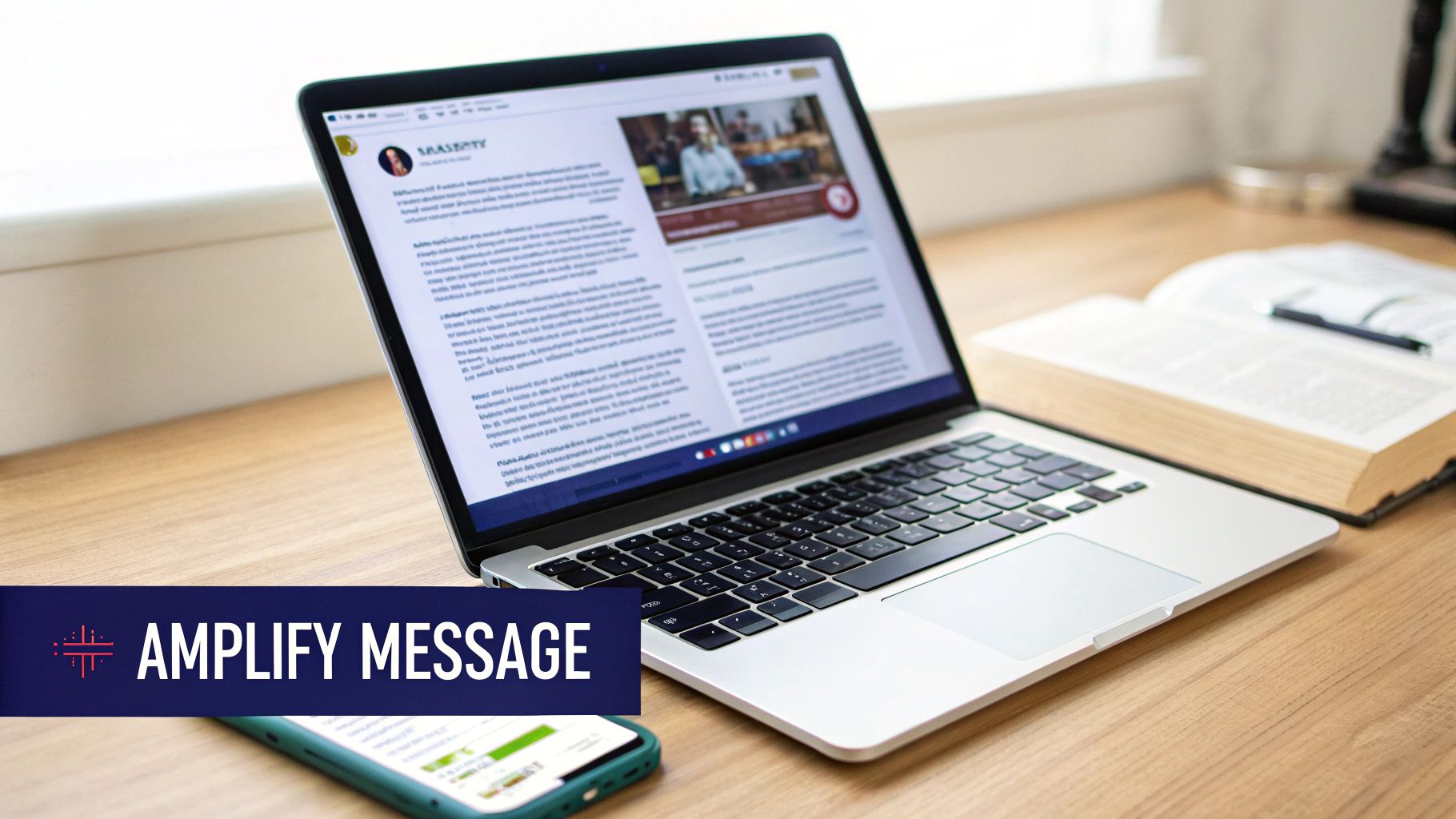
When you say the final "amen" on Sunday, that doesn't have to be the end of the sermon's journey. You've poured hours into study, prayer, and preparation. That message has the power to echo far beyond the four walls of your church.
The trick is to stop seeing your sermon as a one-time event. Think of it as a wellspring of content that can encourage your people all week long. This isn't about adding more to your to-do list; it’s about being a good steward of the work you've already done.
From Sermon Notes to Social Content
Your sermon manuscript is a goldmine. Seriously. Every main point, every sticky illustration, and every practical application can be spun into bite-sized content for social media. The whole idea is to reinforce the central message in different ways, meeting people right where they are during their busy week.
This is where having the right tools in your corner makes all the difference. Technology has certainly changed ministry, and sermon prep is no different. A recent piece in Outreach Magazine pointed out how pastors are using digital tools for everything from deep research to creating engaging content, including AI platforms that make the process a breeze.
With a tool like ChurchSocial.ai, this becomes incredibly straightforward. You can take your sermon and, with just a few clicks, generate a full week's worth of content.
- AI-Generated Content: Create AI-generated reels, social posts, blogs, and more directly from your sermon transcript.
- Graphic Templates: Use a library of templates and an easy-to-use editor to create stunning photos and carousels for social media.
- Calendar Integration: Our simple drag-and-drop calendar allows churches to easily manage all their social media and even integrates with Planning Center and other church calendars to create content for events.
Create Engaging Visuals in Minutes
Let's be honest: people connect with visuals. Turning your sermon's core truths into eye-catching graphics or short video clips is one of the best ways to make the message stick. And no, you don't need to be a professional designer or video editor to do it.
A single sermon can easily fuel a whole host of visual content, reinforcing the message across different platforms.
Using tools built specifically for churches, you can:
- Design with Templates: Jumpstart your creativity with pre-made graphic templates to quickly design branded visuals for your main points.
- Generate Sermon Reels: Let AI find the most powerful moments from your sermon and create short video clips, perfect for Instagram Reels or TikTok.
- Schedule Everything: Plan out and schedule all of this content for the entire week using a simple calendar. It’s a simple way to maintain a consistent, encouraging presence online.
By repurposing your sermon, you're not just creating content—you're continuing the discipleship conversation. You are providing touchpoints of truth that remind your congregation of what they learned on Sunday as they face the challenges of Tuesday.
Getting a clean transcript is the first step in multiplying your content. Using modern audio to text technology makes it easy to get your sermon into a written format for blogs, devotionals, or social media. For a deeper dive, check out our guide on finding the right sermon transcription service for your church.
Wrestling with the Weekly Sermon
Even after years in the pulpit, the rhythm of weekly sermon prep can feel like a grind. We all hit the same walls and ask the same questions. Knowing you're not alone in the struggle is half the battle. Let's tackle some of the most common questions I hear from fellow pastors.
How Long Should This Actually Take Me?
I get this one a lot. The honest answer? It depends. There's no magic number. The complexity of the passage, your own study habits, and the Holy Spirit's timing all play a part.
That said, research gives us a helpful benchmark. A Barna study found that around 70% of pastors spend between 10 and 18 hours preparing a single sermon. That's a huge chunk of the work week, covering everything from exegesis and prayer to writing and rehearsal.
Instead of getting fixated on the clock, focus on your process. A consistent, sustainable weekly rhythm is far more important than hitting a specific number of hours. When you have a reliable process, you can trust that you're putting in the deep work without spiraling into burnout.
What Do I Do When I’m Staring at a Blank Page?
Sermon writer's block is real, and it's incredibly frustrating. The blinking cursor mocks you. The words just aren't there. When this happens, the worst thing you can do is keep staring at the screen. You have to change your state.
Here are a few things that work for me:
- Get Up and Pray. Seriously. Step away from the desk. Go for a walk, put on some worship music, and just spend time with the Lord. Re-centering your heart on why you're doing this can often clear the fog.
- Talk it Through. Find a trusted friend—another pastor, your spouse, a staff member—and start talking about the passage. Articulating your thoughts out loud can spark connections you couldn't see on the page.
- Work on Another Part. Is the intro giving you fits? Forget it for now. Jump ahead and write that illustration you're excited about, or start mapping out your closing thoughts. Making progress anywhere can build the momentum you need to break through the block.
How Do I Make My Sermons Connect with Everyone?
Preaching to a multi-generational room is a huge challenge. How do you make one message resonate with a college student, a young mom, a single professional, and a retiree all at once?
The key is to build bridges from one timeless truth to many different lives. This means varying your illustrations—pull from sports, business, pop culture, and family life. But more than that, it means your application has to speak to different life stages.
A sermon that connects is one that sees the person in the pew. It acknowledges their world and builds a sturdy bridge from the ancient text directly into their modern lives, showing how the gospel is good news for them, right now.
Ultimately, the most powerful connection point is the gospel itself. The shared human experiences of hope, failure, the need for grace, and the promise of redemption—these things cut across every demographic.
How Can I Get More Mileage Out of My Sermon?
You pour 10-18 hours into crafting a message, and it's over in 35 minutes. It doesn't have to be that way. Repurposing your sermon content is one of the smartest ways to help your congregation engage with the message all week long.
This is where you can work smarter, not harder. With a tool like ChurchSocial.ai, you can upload your sermon transcript or audio and let it automatically create a week's worth of follow-up content. Imagine generating social media posts, small group questions, or a blog post for your website. You can even create AI-generated video clips of key moments and schedule everything out with a simple drag-and-drop calendar. You did the hard work of preparing the message; let technology help it echo.
Find out more and start a free trial of ChurchSocial.ai.

